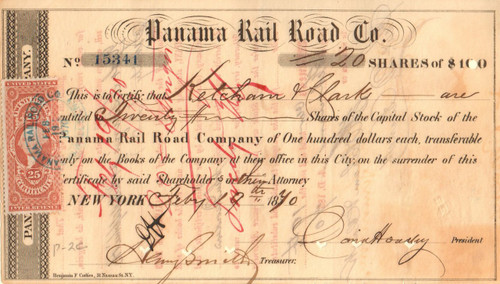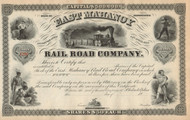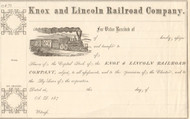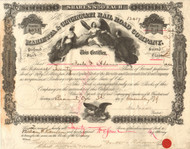Categories
Categories
- Home
- Railroad
- 1800's Railroads
- Panama Rail Road Co. 1870
Panama Rail Road Co. 1870
Product Description
Panama Rail Road Co. stock certificate 1870
Very rare and desirable railroad certificate from the Panama RR. Pen cancelled with revenue stamp to the left. Smaller cert measuring 4.25". Dated 1870. Very tough to find piece.
The Panama Canal Railway is a railway line that runs parallel to the Panama Canal, linking the Atlantic Ocean to the Pacific Ocean in Central America. The route stretches 47.6 miles across the Isthmus of Panama from Colón (Atlantic) to Balboa (Pacific). It is operated by Panama Canal Railway Company and is jointly owned by Kansas City Southern and Mi-Jack Products. The Panama Canal Railway currently provides both freight and passenger service.
The infrastructure of this railroad (formerly named the Panama Railway or Panama Rail Road) was of vital importance for the construction of the Panama Canal over a parallel route half a century later. The principal incentive for the building of the rail line was the vast increase in traffic to California owing to the 1849 California Gold Rush. Construction on the Panama Railroad began in 1850 and the first revenue train ran over the full length on January 28, 1855.
In January 1849, Aspinwall hired Colonel George W. Hughes to lead a survey party and pick a proposed Panama Railroad roadbed to Panama City. The eventual survey turned out to be full of errors, omissions, and optimistic forecasts, which made it of very little use. In April 1849, William Henry Aspinwall was chosen head of the Panama Railroad company, which was incorporated in the State of New York and initially raised $1,000,000 in capital.
In early 1850, George Law, owner of the Pacific Mail Steamship Company, bought up the options of the land from the mouth of the Chagres River to the end of Navy Bay in order to force the directors of the new Panama Railroad to give him a position on the board of the company. Since there were no harbor facilities on the Atlantic side of the isthmus, they needed to create a town with docking facilities to unload their railroad supplies there. Starting in May 1850, what would become the city of Aspinwall (now Colón) was founded on the 650 acres on the western end of a treacherously marshy islet covered with mangrove trees, known as Manzanillo Island.
Before the railroad construction could get fully started, the island was connected to the Panamanian mainland by a causeway supported by pile-driven timbers. The first rolling stock consisting of a steam locomotive built by William Sellers & Co., and several gondola cars arrived in February 1851. The required steam locomotives, railroad cars, ties, rails, and other equipment were unloaded at the newly constructed docks and driven across the track laid across the about 200 yards causeway separating the island from the mainland.
Cholera, yellow fever, and malaria took a deadly toll, and despite the constant importation of large numbers of new workers, there were times when progress stalled for simple lack of alive and semi-fit workers. All supplies and nearly all foodstuffs had to be imported from thousands of miles away, greatly adding to the cost of construction. Laborers came from the United States, the Caribbean Islands, and as far away as Ireland, India, China, and Australia.
After almost 20 months of work, the Panama Railroad had laid about 8 miles of track and had spent about $1,000,000 to cross the swamps to Gatun. The project's fortunes turned in November 1851 — just as they were running out of the original $1,000,000 — when two large paddle steamers, the SS Georgia and the SS Philadelphia, with about 1,000 passengers, were forced to shelter in Limón Bay, Panama, due to a hurricane in the Caribbean. Since the railroad's docks had been completed by this time and rail had been laid 8 miles up to Gatún on the Chagres River, it was possible to unload the ships' cargoes of emigrants and their luggage and transport them by rail, using flatcars and gondolas, for at least the first part of their journey up the Chagres River on their way to Panama City.
By July 1852, it had finished 23 miles of track and reached the Chagres River, where a massive bridge had to be built. The first wooden bridge failed when the Chagres rose by over 40 feet in a day and washed it away. They started work on a much higher, 300-foot-long (91 m), massive iron bridge, which took over a year to finish. In all, over 170 more bridges and culverts had to be built.
In January 1854, excavation began at the summit of the Continental Divide at the Culebra Cut, where the earth had to be cut down from 20 feet to 40 feet deep over a distance of about 2,500 feet. Several months were spent digging. Later the Panama Canal would require years to cut it deep enough for a canal. The road over the crest of the continental divide at Culebra was finally completed from the Atlantic side in January 1855, 37 miles of track having been laid from Aspinwall (Colón). A second team, working under less harsh conditions with railroad track, ties, railroad cars, steam locomotives, and other supplies brought around Cape Horn by ship, completed its 11 miles (18 km) of track from Panama City to the summit from the Pacific side of the isthmus at the same time. On a rainy midnight on January 27, 1855, lit by sputtering whale oil lamps, the last rail was set in place on pine crossties.
The railroad became one of the most profitable in the world, charging up to $25 per passenger to travel over 47 miles of hard-laid track. Upon completion, the railway was proclaimed an engineering marvel of the era. Until the opening of the Panama Canal, it carried the heaviest volume of freight per unit length of any railroad in the world. The existence of the railway was one of the keys to the selection of Panama as the site of the canal.
In 1881 the French Compagnie Universelle du Canal Interocéanique purchased controlling interest in the Panama Railway Company. In 1904, the US government under Theodore Roosevelt purchased the railway from the French canal company. At the time, railway assets included some 75 miles (121 km) of track, 35 locomotives, 30 passenger cars, and 900 freight cars. Much of this equipment was worn out or obsolete and had to be scrapped.
The railroad was built and originally owned by a publicly traded corporation based in New York City, the Panama Rail Road Company, which was chartered by the State of New York on April 7, 1849, and the stock in which would eventually become some of the most highly valued of the era. The company bought exclusive rights from the government of Colombia to build the railroad across the isthmus.
It is estimated that from 5,000 to 10,000 people may have died in the construction of the railroad, though the Panama Railway company kept no official count and the total may be higher or lower. Cholera, malaria, and yellow fever killed thousands of workers. Disease and exhaustion took a heavy toll on workers, in part because the connection between mosquitoes and malaria would not be discovered for another 40 years. The disposal of unidentifiable bodies was a boon to the PCRC, mostly paid for by medical facilities. Medical schools and teaching hospitals needed cadavers to train budding physicians and paid handsomely for anonymous bodies pickled in barrels shipped up from the tropics. The PCRC itself sold the corpses abroad, and the income generated was sufficient to maintain the company's own hospital.
 Loading... Please wait...
Loading... Please wait... 








